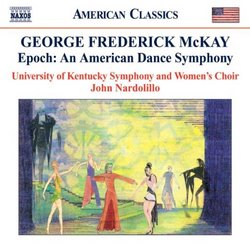| All Artists: U. of Kentucky Symphony & Women's Chorus, John Nardolillo Conductor Title: George Frederick McKay: Epoch - An American Dance Symphony Members Wishing: 0 Total Copies: 0 Label: Naxos American Classics Release Date: 9/30/2008 Genres: Pop, Classical Styles: Vocal Pop, Symphonies Number of Discs: 1 SwapaCD Credits: 1 UPC: 636943933022 |
Search - U. of Kentucky Symphony & Women's Chorus, John Nardolillo Conductor :: George Frederick McKay: Epoch - An American Dance Symphony
 | U. of Kentucky Symphony & Women's Chorus, John Nardolillo Conductor George Frederick McKay: Epoch - An American Dance Symphony Genres: Pop, Classical |
Larger Image |
CD Details |
CD ReviewsAhead of its Time sdtom | san diego ca. | 10/05/2008 (3 out of 5 stars) " Talk about someone being under the radar and you'll certainly include the name of George Frederick McKay. Until the recent releases by Naxos, in their ever-expanding American Classics series, McKay had gotten little or no airplay since his death in 1970. Perhaps it was due to the fact that George spent most of his life in the Pacific Northwest, not exactly the same kind of exposure Copland received in New York. Known as the "Dean of Northwest Composers", McKay was a Professor of Music at the University of Washington for 41 years leaving the area only for a short time to study at the Eastman School of Music and short stints as a conductor in North Carolina, Missouri, and South Dakota. Composed in 1935 Epoch: An American Dance Symphony was given an extremely favorable review at the premiere by both daily Seattle newspapers. The dance is based on American history as seen through the eyes of some of its greatest poets Edgar Allen Poe, Sidney Lanier, Walt Whitman, and Carl Sandburg, coincidentally all honored by the US Postal Service with stamps. The four sections of the work cover "Symbolic Portrait" (Poe), "Pastoral" (Lanier), and "Westward!" (Whitman), and "Machine Age Blues" (Sandburg) with the "Epilogue" the fifth episode unfinished with the comment from George that this is being prepared by time and will be written and enacted by us all. "Symbolic Portrait" certainly touches upon the softer side of Poe as well as his curiosity of the ghastly side of life. The choreography ranged from romantic to the macabre (dance of death). While the music in parts is quite dark and dissonant (brass passages) George certainly maintained a melodic nature through the 14+ minutes with solos from harp, flute, and oboe, a struggle between good and evil. "Pastoral", featuring the University of Kentucky Women's Choir, is a section of pure peace and tranquility. Lanier also played flute and composed, one of his works being Hymn of the Marshes (blackbirds) so the references to the birds could certainly have been one of the contributing factors when composing this second episode. "Westward", the third episode, is the Whitman section which depicts the beginning of the industrial age with timpani and brass type motif followed by the beckoning of the call of the mourning Cor Anglais to go west to the prairie to settle in the unknown and exciting new land. The episode also includes the movement of the wagons, a tom-tom Indian reference and a playing of the folk tune "Turkey In The Straw", appropriate music as it was written in the early 19th century. The fourth episode "Machine Age Blues" written about Carl Sandburg and likely in reference to his poetry in his book Smoke and Steel must have shocked the audience with its brash dissonant approach to the 'Steel Age' of the early 20th century. Very much in the Gershwin style it includes riveting, jackhammers, and the sound of a very busy city. It also includes some slow blues, Charleston flapping featuring saxophones, and dance material of the era. Then it just suddenly builds to a loud crescendo and ends with the timpani motif, which started the beginning of the "Westward" episode. Performed by the University of Kentucky Symphony Orchestra and Women's Chorus the recording sounded fine especially given the fact that this is very likely made up of students. The music is overall very melodic, and very easy to follow after reading the liner notes from the McKay family. To hear the music is like listening to a separate soundtrack from a film never viewed and this reviewer would be very interested to see first hand a performance of the dance. One can hope that there will be future recordings from this excellent American composer. Recommended. Naxos CD# 8.559330 Produced and Engineered by Tim Handley Track Listing: 1... Symbolic Portrait (Poe) (14:16) 2... Pastoral (Lanier) (15:28) 3... Westward! (Whitman) (18:49) 4... Machine Age Blues (Sandburg) (13:47) Total Time is 62:52 " Living American Music History Alden Werkmeister | 01/24/2009 (5 out of 5 stars) "George Frederick McKay's Epoch dance score is highly evocative of a period in the American experience which saw the demise of the free-wheeling 1920's era, and the onset of world economic depression and chronic modern warfare. It was created by youthful dancers, musicians and designers of a large West Coast university who were cognizant of the awesome changes going on in human society, science and politics. This world premiere recording has received praise from a wide range of critics including Richard Freed, who reviews for the New York Times and Soundstage.com. McKay's music is rife with satire concerning modern times and exudes a painful longing for the sweetness of a lost natural world.
" |
